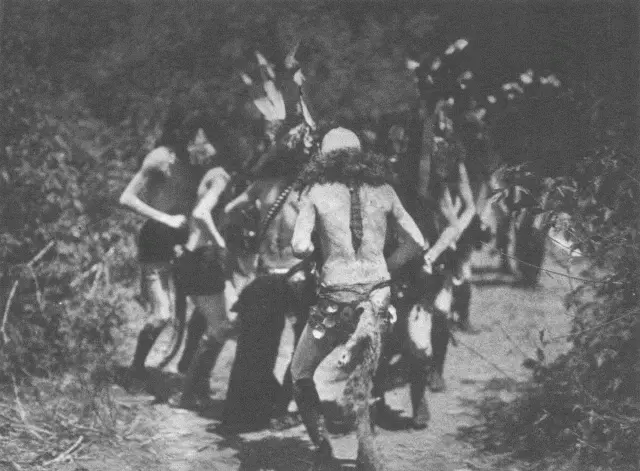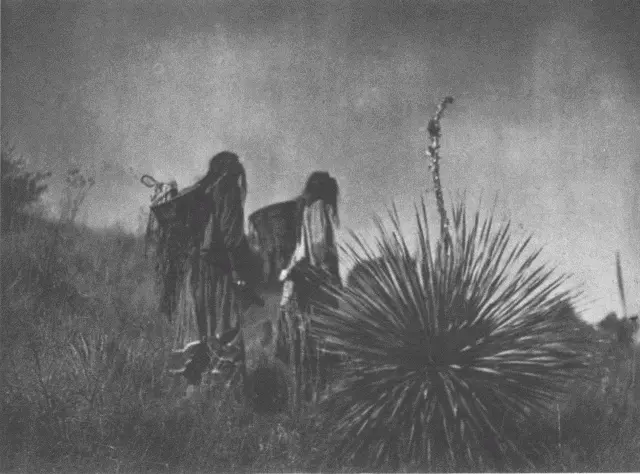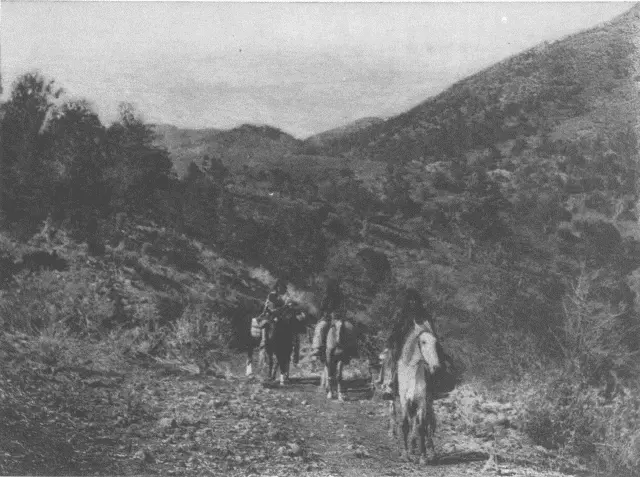The ceremony proper consists of little more than songs. A medicine-man is called upon to take charge, being compensated for his services with blankets, robes, grain, or other articles of value. Friends and neighbors having been notified, they assemble at the girl's hogán fairly early in the evening. When dusk has settled, the medicine-man begins his songs, singing first the twelve "hogán songs" of the Bahózhonchi. After he has finished, anyone present who so desires may sing songs taken from the ritual of the same order. This motley singing and hilarity continue until well toward sunrise, when the mother brings in a bowl of yucca suds and washes the girl's hair. Her head and hair are dried with corn-meal, after which the girl takes her last run toward the east, this time followed by many young children, symbolically attesting that she will be a kind mother, whom her children will always follow. The hatálĭ, or medicine singer, during her absence sings eight songs, generally termed the Racing songs. On her return the great corn-cake is brought in, cut, and divided among the assemblage, when all disperse, and the girl may once more loosen her hair and partake of any food she pleases.
Table of Contents

Yébĭchai Dancers - Navaho
The Navaho marriage ceremony is always held at the home of the girl. When a young man wishes to marry the maid of his choice, he makes his desire known to his parents, when the father goes to the girl's parents and explains that his son would like to marry their daughter. The girl is then consulted, and if she be willing to marry the young man, the parents of the two open negotiations. A popular, pretty girl commands a considerably higher price than a plain one, though few are married for a smaller bonus than fourteen ponies and a silver belt. Horses, saddles, cattle, sheep and goats, and turquoise-studded silver ornaments are the usual media of exchange in matrimonial bargains. The arrangement of compensatory details, particularly the date of delivery of the articles for payment, often requires a considerable period of time and no little controversy. When finally completed, the date is set for the wedding, which takes place always at night.
The girl's mother fills a wedding basket with corn-meal mush, which figures prominently in the ceremony. About nine o'clock in the evening the wedding party assembles. Anyone may attend, and usually a goodly number is present. The young man and his bride take seats on the western side of the hogán, facing the doorway. On their right the male spectators sit in rows; on their left, the women. The girl's mother, however, does not enter, for a mother-in-law, even in the making, must not look upon her newly acquired son, nor he upon her, then or thereafter. To do so would occasion blindness, and general ill luck to either one or both parties.
The basket of mush and two wicker bottles of water are brought in and placed before the couple, the bearer being careful to see that the side of the basket on which the top coil terminates is toward the east. The girl's father then steps forward, and from his pouch of tádĭtĭn, or sacred pollen, sifts several pinches on the basket of mush. Beginning at the end of the coil on the eastern rim, he sifts straight across and back, then follows the rim with the pollen around to the south side, sifts across and back, and then drops a little in the centre. That done, the bride pours a small quantity of water from the wicker bottle upon the young man's hands. He washes and pours a little upon hers. Then from the side of the basket toward the east he dips out a little mush with two fingers and eats. The girl follows, dipping from the same place. This act is repeated at the three remaining sides—the south, west, and north,—and then the basket is passed to the assemblage, who finish eating its contents. The empty basket becomes the property of the young man's mother, who retains it as a sort of certificate of marriage. The washing of hands and the dipping of mush from the same spot is a pledge that the girl will follow in her husband's footsteps—doing as he does.
When the ceremony is concluded, a supper is provided for all. General conversation and levity while away the hours, the talk consisting principally, however, of sage advice from relatives to both husband and wife as to how they should conduct themselves in future. At dawn the party disperses, the young man taking his bride with him.

Mescal Harvest - Apache
Table of Contents

White River Valley - Apache
Tribal Summary - The Apache
Table of Contents
Language—Athapascan.
Population—Fort Apache Agency, Arizona (White Mountain Apache), 2,072.
San Carlos Agency: San Carlos Apache, 1,066; Tonto Apache, 554; Coyoteros, 525.
Tonto Apache on Beaver Creek, 103.
Total Apache of Arizona (not including the so-called Mohave Apache and Yuma Apache), 4,320.
Mescaleros in New Mexico, 460. Jicarillas in New Mexico, 784.
Chiricahua Apache at Fort Sill, Oklahoma, 298. Kiowa Apache in Oklahoma, 155.
Grand total of Apache tribes, 6,017.
Dress—The primitive dress of the men was deerskin shirt (ĕpŭntltésĭs), leggings (ĭsklé̆tlĭkai), and moccasins (ĕpú̆nkĕ). They were never without the loin-cloth, the one absolutely necessary feature of Indian dress. A deerskin cap (cha), with attractive symbolic ornamentation, was worn; but for the greater part the headgear consisted of a band braided from the long leaves of the yucca, which they placed rather low on the head to keep the hair from the eyes. The dress of the Apache women consisted of a short deerskin skirt, high boot-legged moccasins, and a loose waist which extended to the hips and was worn outside the skirt. Both skirt and waist were ornamented with deerskin fringe and latterly with metal pendants. The men's hair always hangs loose; it is never braided. At time of mourning the hair is cut horizontally just above the shoulder line. Apache matrons, like the men, do not braid the hair, but let it hang loosely over the shoulders. The maidens tie their hair in a low long knot at the back of the head, to which is fastened a decorated deerskin ornament, denoting maidenhood. So arranged it is called pĭtsĭvé̆sti, and the wrapping, tsĭgé̆.
Dwellings—The Apache dwelling consists of a dome-shaped frame of cottonwood or other poles, thatched with grass. Average diameter at the base, twelve feet. The house itself they term kówa; the grass thatch, pin. Bear-grass, or what the Spanish term palmillo, is used exclusively in thatching. Since the institution of the Messiah religion the houses are built rather elongate in form, with a doorway in each end, and all the houses of the village are arranged in long rows. Doorways are termed dáitin, or chogúntĭ, interchangeably. Summer houses are generally built at a distance from the winter houses, in fact wherever the Apache would have occasion to stop, and are little more than brush shelters to afford temporary shade.
Primitive Foods—No tribe is more capable of living on the natural products of their pristine haunts than the Apache. Whether allowed to live peacefully in the river valleys or driven in war to seek protection of impenetrable mountains, nature provided amply for their support; for practically all the flora and fauna indigenous to the Southwest are considered food by the Apache. (See the list in the vocabulary.)
Читать дальше















